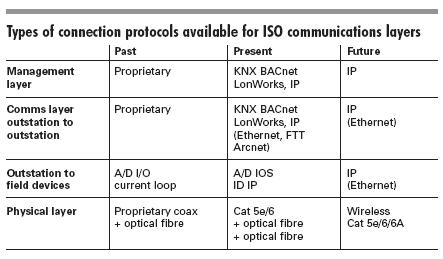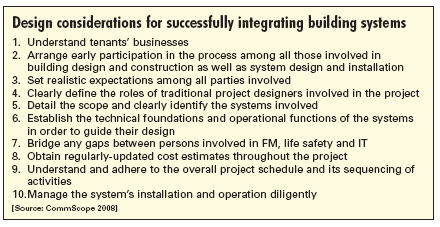Brainy Buildings?
Occupiers are increasingly demanding data and intelligence from their building systems. However, as Frank Booty explains, the proliferation of existing proprietary systems and developments in new technologies is presenting a challenge.
There is no universal defination for the term ‘intelligent building’. After all, no building is going to have to sit an exam to prove its brain power and analytical capacity. However, it will one day have to be examined for its facilities’ capabilities — and associated energy performance. That’s not entirely unrelated to the intelligence within the building either. One definition follows the line that an ‘intelligent building’ provides a productive and cost-effective environment because its four basic components — structure, systems, services and management — have been fully integrated, creating the optimum design. This much has been noted and aired since the mid 1980s — yet rarely seen.
|
|
Intelligent buildings need FM to assist in defining requirements, justifying investment and ensuring the intended benefits are actually delivered. FMs themselves simultaneously require intelligent buildings to control building performance, manage distributed services, adapt readily to changing needs and provide key management information.
Building owners/operators, FMs and tenants are all demanding value and performance from their facilities. Buildings have to provide costeffective, productive, safe and flexible working environments. The operators/owners/FMs need operational efficiencies that generate cost savings while tenants want enhanced services that translate into autonomy, comfort and higher productivity.
There are a number of technology advances and industry trends that are making it possible for today’s buildings to respond to these challenges. These include the migration to IP-enabled devices and IP networks; the growing convergence of enterprise networks; a focus on interconnecting facilities and accessing real-time data; the increased use of wireless technologies; and the renewed attention on environmental and energy efficiency.
One company that is recognising that the convergence of these events can result in intelligent buildings offering real benefits — because of the way they allow building systems to integrate and communicate — is CommScope. Commscope is a trendsetter in infrastructure solutions for communications networks. Its business partners install over 1,000 miles (1,600 km) of its Systimax cable every day in over 130 countries. It recently absorbed parts of AT&T, Avaya and Lucent, and added Andrew, which is a key player in wireless communications. CommScope plays in a market populated with many contenders such as Johnson Controls, Honeywell, Andover, Hewlett-Packard, Juniper Networks and Cisco for which it is a technology developer partner.
Many of a building’s ongoing costs relate to the low voltage systems that provide and sustain the building’s functionality. Some 75 per cent of a building’s lifetime cost will derive from ongoing maintenance and operating expenses. As the average life of a building is 30 to 40 years, these costs for that lifetime can be staggeringly high. Any innovation that simultaneously reduces cost over time while also enhancing building performance must hold substantial appeal. Intelligent buildings offer such innovation.
Intelligent buildings harness technology and link building systems to supply more efficiency, higher productivity and increased comfort. Most buildings feature 10 to 46 low voltage systems, each calling for its own control, management and monitoring over the decades of the building’s lifetime. Without a common infrastructure that can link them together, these dozens of systems can create a lifetime accumulation of unnecessary cost and commotion. But with a single backbone supporting all of these systems – from security to lighting, HVAC to communications – building operations can become high performance and cost effective.
The universal trend among innovative buildings has been identified as leading toward an infrastructure solution that CommScope has dubbed Intelligent Building Infrastructure Solutions or IBIS.
|
|
IBIS encompasses many applications with one infrastructure. That’s CCTV, IP video surveillance, alarms and sensors, access, HVAC, lighting, 24×7 monitoring, lifts, fire, energy and communications. This leads to the connected real estate, a converged infrastructure fed by building systems (IP building platform) and information systems (IP communications platform). Cisco realised some three years ago it could provide a converged infrastructure. The business drivers take account of the fact that a goal is centralised management. Consider how traditional building automated systems cabling is implemented — proprietary cabling comes with the equipment, there’s the cost of moving cables and containment, the cost of additional cables and containment, ‘fork lift’ upgrades, disruption and system downtime. It is an ongoing expense.
CommScope has a compelling case for installing IBIS — a single cabling contractor and coordination of project activities; easier to operate, change and maintain given a 40 year building lifespan and a 20 year cabling lifespan; standards-based and open systems architecture; and provides a basis for future developments. Cost benefits accruing are capital expenditure reduction (savings on cabling and equipment costs); savings on commissioning time, construction financing costs, and operational and maintenance costs; and the ability to take advantage of any technological developments giving a better return on investment.
Future drivers for intelligent buildings will be IT, robotics, smart materials, sustainable issues and the impacts of social change. Besides technological developments, other factors will include climate change, changes in (building) regulations, and how people live and work within such buildings. Other drivers include energy efficiency ratings of buildings (e.g. the mandatory provision this year of energy performance certificates).
Where FMs have separate low voltage systems running over separate cabling, he or she should ‘think integrated ‘ for the future. What about standards? Hitherto efforts in the industry resulted in a consortium of building management companies, system users and manufacturers working to alter the industry to an open environment. These efforts resulted in two major industry standard protocols — BACnet and LonWorks.
BACnet (Building Automation and Control networks) protocol was developed by the American Society of Heating, Refrigeration and Air-Conditioned Engineers (ASHRAE) and is the oldest and most widely deployed standard for intelligent building systems. LonWorks was developed by Echelon Corp and needs a proprietary neuron chip in controllers which connect individual devices to the overall system. In 2002, the industry’s standards bodies produced guidelines for a structured cabling infrastructure to support intelligent buildings. Now, ANSI/TIA/EIA-862 lays out the BAS (building automation systems) cabling standard for commercial buildings. Other standards on the market or imminent include IEEE 802.3af (concerning power), draft IEEE 802.3at, which concerns power delivered over Ethernet Plus; IETF IPv6; and industrial Ethernet.
There will inevitably be a merging of network control. Hitherto there were distinct roles for telecom, IT, energy, corporate real estate and facilities managers. Ultimately with an all IP deployment of networks, the intelligent building will in many cases mean a shifting, or realignment, of responsibilities and domains, and some people will feel upset at having to give up control. But that comes with progress, which actually might take longer to happen than many people think.
Down under
The Lyell McEwin Health Service Hospital in Adelaide, Australia, utilises Systimax structured connectivity solutions to connect applications ranging from MRI scanners to heating and ventilation. Hitherto, the hospital with its 200 beds, centres for same-day treatment and student teaching, used Systimax PowerSUM UTP copper cabling and 110 patching hardware to connect its systems. But to equip the new facilities and improve connectivity in existing buildings, it wanted an upgraded cabling cabling infrastructure able to support new networkintensive systems and simultaneously the hospital wanted to make savings in its operational costs. As well as higher performance the hospital specified its new structured cabling solution should serve all low voltage applications on the site.
As well as data and voice, these include systems for security, nurse call, medical diagnostics, heating and ventilation, access control, wandering patient alarms and CCTV. It was decided to move forwards with new generations of copper and fibre cabling solutions from Systimax.
Simultaneously with upgrading the cabling, the hospital moved away from the interconnect method of linking servers and other devices to distribution frames. Instead the new installation utilises the cross connect method to improve flexibility and manageability by simplifying rearrangements, upgrades and moves of equipment. Cross connection also has the advantage of faster system restorations when equipment is changed.
Frank Booty is a freelance writer.

